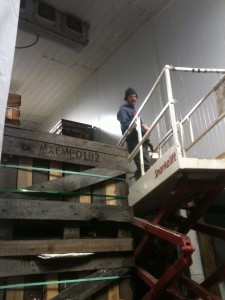As an engineer, I love data. It turns out farmers do also. At least, Pete Johnson and Isaac Jacobs at Pete’s Greens in Craftsbury, VT do. “Is it working yet?” Isaac asks as I put the finishing touches on the remote data monitoring system we have been installing in the four zone drive-in cooler. “Just about… I think.” I say with trepidation. Isaac has been up and down in a scissor lift several times at placing and removing a sensor that was being difficult. And I’ve been wrestling with a data station to make it communicate over the wireless network so that we can actually see the data being collected by the new remote monitoring system.

This is the first time we’ve installed this kind of system which consists of a “base station” and “remote sensors”. The remote sensors in this case measure temperature and relative humidity (RH), both parameters which can drastically influence the storage life, quality and food safety of produce. In fact, the motivation for multiple storage “zones” in the cooler is to provide each group of vegetables their desired set of conditions; e.g. potatoes at 38 °F and 90-95% RH, onions at 32 °F and 65-70% RH, cabbage at 32 °F and 99% RH and squash at 55 °F and 70% RH.

“What are those spikes in temperature?” Pete asks as we glance over the first set of data that pops onto the screen. There are spikes in temperature every 8 hours in the potato room that last about one hour. Not big spikes (2 °F above the nominal), but they stand out. And perhaps as important, relative humidity drops by 2% when the temperature goes up.
Later, when Isaac and I are looking at the electrical wiring to see where we can plug in additional sensors we note that evaporator defrost system in that room is on an 8 hour timer; that’s the source of the heat. “Well, they don’t even need to be on right now, that room isn’t even being cooled.” The circuit breakers for the evaporator heaters (intended to defrost the evaporator when it freezes up) are shut off, reducing the farm’s electric bill slightly over the next few months. And this is only two hours after we started getting data.
The power of data is three-fold. First it is inspired by inquisition. It then raises additional questions and with further review, it should answer questions and improve life. The principle behind this project is to allow for easier access to process data for Vermont’s growers and to demonstrate this type of system. As farms push the seasonal envelope in response to increased local demand, year-round production and long term storage of fruits and vegetables will be increasingly important. I plan to use this system at multiple locations in Vermont to collect data on refrigerated storage, greenhouse and high tunnel production, and whatever else comes along that is interesting and makes sense.